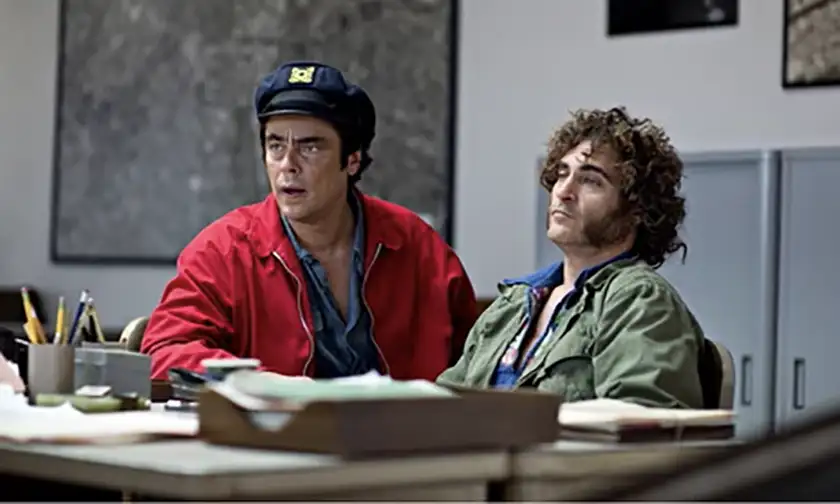Inherent Vice feels inaccessible and unnatural, but the film offers enough of Paul Thomas Anderson’s signature touch to warrant further investigation.
Inherent Vice is more than a stoner film. If anything, it’s a stoner epic.
Paul Thomas Anderson’s 2014 odyssey is a long and winding road, weaving in and out of the past and the present, between reality and fantasy, without letting the audience in on which is which. The film often gets left out of any conversation regarding the auteur’s best works. And maybe that makes sense, given the film’s convoluted narrative. Inherent Vice, however, refuses to play by the rules, relishing in its nonsense while also giving those who are willing to stick it out a deeply moving portrait of regret.
The main critique lobbed at Inherent Vice is its plot, which many critics and filmgoers deemed uneasy to navigate, or even inaccessible. On a first watch, this complaint holds merit. The film is more Punch-Drunk Love than it is There Will Be Blood, both in terms of tone and how it focuses on the subjective, rather than the objective. Joaquin Phoenix (Joker) plays “Doc” Spotello, a hippie (who does quite a lot of drugs) in 1970s California working as a private investigator. Doc quickly finds himself trying to unravel a series of cases relating to his ex-girlfriend’s (Katherine Waterston, of The End We Start From) disappearance. The audience follows Doc on his journey, while he encounters strange characters, drug cartels, and neo-Nazi prison gangs, while forming an uneasy alliance with an LAPD detective (Josh Brolin, of Dune: Part Two).
The movie’s structure is unconventional, but this unconventionality is intentional. The film plays as a throwback movie from the era in which it takes place. Many of these films were about the mood, tone, and emotion of the characters, rather than the plot itself. It follows that our lead character, a stoner, gets lost and entangled in his own affairs, and the movie takes the audience on that same journey of loss and entanglement. As the story unfolds, revelations about Doc’s past with his ex-girlfriend, named Shasta, realign the film as less of a detective tale, and more a rumination on regret. Doc looks back on his past with clarity, even as the present becomes increasingly difficult to traverse. Saying “the fact that the plot doesn’t make sense is the POINT, man,” feels like a copout, and perhaps it is. But to critique the film for its lack of structure and overcomplication is to miss how intentional the choice was on PTA’s part.

Even without this debate about the film’s plot, it feels impossible to deny that Inherent Vice is firing on all technical cylinders. The setting of 1970s Los Angeles makes way for beautiful cinematography from frequent PTA collaborator Robert Elswit. The cast, also including the likes of Owen Wilson, Reese Witherspoon, Benicio del Toro, Jena Malone, Martin Short, and Hong Chau, each add a unique sense of humor to the characters, serving as either compliments or foils to Phoenix’s equally hilarious performance.
The film’s best moment is a flashback Doc experiences, a beautiful moment as he and Shasta run barefoot in the rain, without a care in the world. It might be easy to overlook this moment, especially in a movie that is hard to get a grip on. But this moment captures Inherent Vice’s theme of regret, and finding solace in the past when the present is so confusing. The movie might be even more inaccessible than some of PTA’s other oblique work, but it features more than enough magic and aesthetic beauty worth exploring in a deeper way.
Inherent Vice is now available to watch on digital and on demand. Read our list of all of Paul Thomas Anderson ’s films ranked from worst to best.
Loud and Clear Reviews has an affiliate partnership with Apple, so we receive a share of the revenue from your purchase or streaming of the films when you click on the button on this page. This won’t affect how much you pay for them and helps us keep the site free for everyone.

